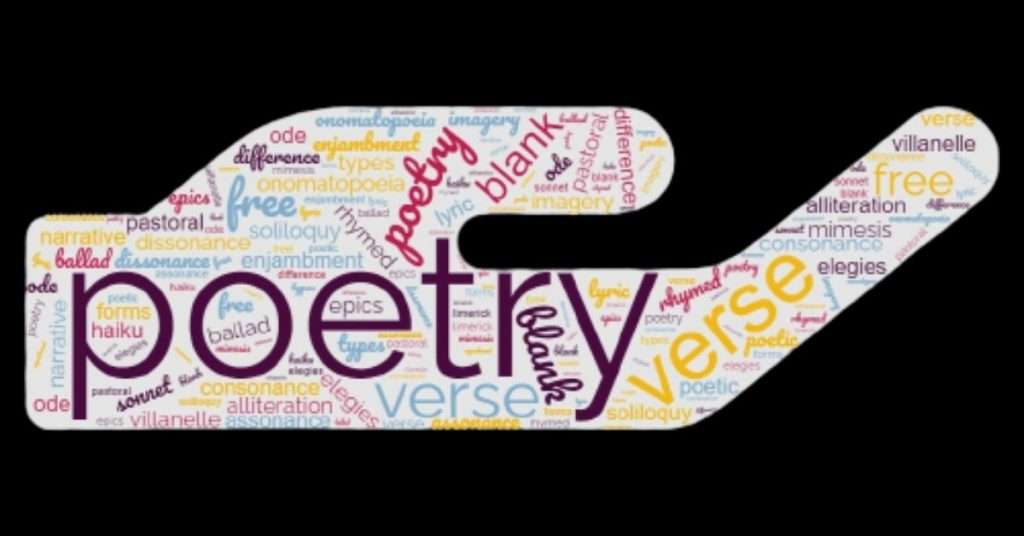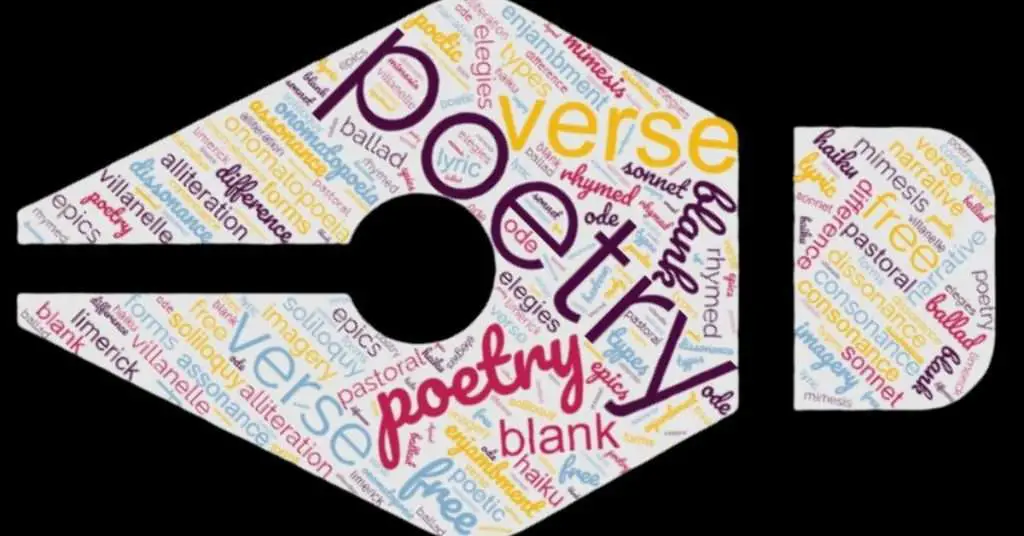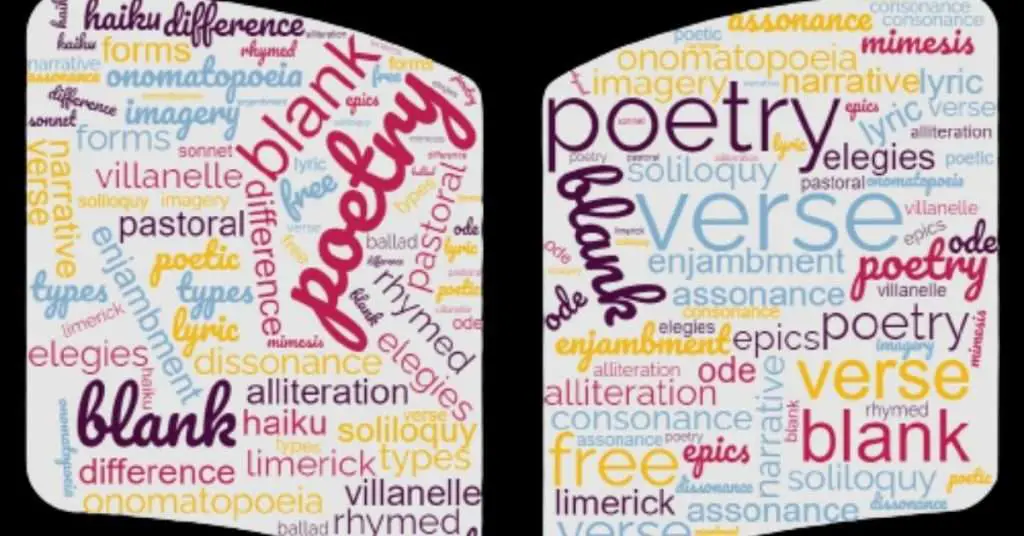Here are 12 Types of Poetry You Need to Know

What is your favorite type of poetry? Whether you enjoy free verse or sonnets, there is no denying that poetry is a powerful form of expression. Each type of poetry has its own unique style and structure, which can make it both fun and challenging to write. In this blog post, we will explore some of the most popular types of poetry. So grab your pen and paper (or open up a new document on your computer) and let’s get started!
Affiliate Disclaimer: This post may contain affiliate links, which means I will receive a commission if you make a purchase using these links.
Popular Poetry Types
There are many different types of poetry, each with its own unique features and beauty. One of the most popular forms of poetry is the long poem.
Long poems can be written on any subject and can take any form, from a traditional rhyming verse to a more modern free-form style.
Another popular type of poetry is the English sonnet. The English sonnet consists of fourteen lines of iambic pentameter, with a rhyme scheme of ABAB CDCD EFEF GG. Sonnets often explore themes of love, loss, and time.
Other common types of poetry include haiku, ghazals, and odes. Haiku are short Japanese poems that typically consist of seventeen syllables arranged in three lines of five, seven, and five syllables respectively.
Ghazals are Persian poems that consist of couplets that rhyme and have the same metre. Odes are poetic works that praise or celebrate a particular subject, such as nature or love.
No matter what type of poetry you enjoy, there is sure to be a poem out there that speaks to you.
Short Poems
Short poems are a form of poetry where the words are short and concise. This section includes information about the typical length, the origins of the form, and examples from well-known poets.
If you need a quick burst of inspiration or if you’re looking for an easy assignment to complete in class, then short poetry is the way to go.
Short poetry differs from regular poetry in that it is typically written in very few lines and usually doesn’t exceed the length of one page.
It is not necessary for these poems to rhyme but they often do. Some famous poets who wrote short poems include Emily Dickinson and William Wordsworth.
1. Haiku
Haiku are Japanese poems, consisting of 17 syllables over 3 lines. In haiku poetry, the first line has five syllables, the second line has seven syllables, and the third line has five syllables.
Haiku can be about anything, but they often capture a moment in time or express a feeling in a snapshot-like way. The subject matter covered in haiku can be about nature, love, or any other topic.
The simplicity of the form lends itself to being easy to write and often evokes strong emotions in the reader.
An Example of a Haiku Poem:
Here is an example of haiku written by Matsuo Basho (1644-1694). He is said to be one of the greatest haiku poet:
An old silent pond…
A frog jumps into the pond,
splash! Silence again.
2. Epitaph
The word epitaph derives from the Greek words epi and taphos, meaning “on burial.” An epitaph is an inscription on a memorial plaque or tombstone that honors the person’s life and accomplishments.
Thoughtful epitaphs often provide insight into the life of the deceased.
Epitaphs are a common way to express feelings or thoughts about a person who has died. They can be used for a variety of reasons, from memorializing the deceased to celebrating their life.
Example of an Epitaph:
This is Floyd Patterson epitaph, dubbed “The Gentleman of Boxing,” who won an Olympic gold medal and twice reigned as world heavyweight champion during his two decades in the ring.
In Loving Memory of
Floyd Patterson
Jan. 4 1935 – May 11, 2006
Husband, Father, Grandfather and Friend
A Champion Always
3. Epigram
Epigrams focused on the subtleties and nuances of language. They are short poems that often rely on wit and irony to convey meaning.
They typically employ ironic understatement. Understatements create a sense of paradox or contradiction. The term “epigram” is derived from the Greek word epígramma, meaning “inscription.”
An epigram is a brief, interesting, and thoughtful statement. It can be found in many forms of poetry and typically features a witty turn of phrase. It is a type of aphorism that can consist of one or more lines.
They often start with the last word of the preceding sentence. For example, “in excellence, is no intermission.” In this line from Shakespeare’s Sonnet 18, it is inferred that there should be no break in excellence.
Example of an Epigram:
Experience is the name everyone gives to their mistakes.
In this example taken from a post on the Literary Terms website, here, wit and brevity convey the bigger concept that people soften their mistakes by claiming to have learned from them.
Rhyming Poems
Many forms of poetry use rhyme, but it is an art used most notably in the form of rhyming poems. This may be because rhyme allows for both lengthier sentences and shorter, more rhythmic ones.
The rhymes also help to provide structure for the poem. Rhyming poems are often written in iambic pentameter, which can be utilized to represent consistency.
In a time where rhymes are all but gone from our language, there is still a place for those who use the poetic form to communicate.
Rhyming poems help to create a rhythm that has a natural flow and can perhaps be considered educational. Rhyming poems also give people the opportunity to express themselves in a way that is unique and different from other forms of poetry.
4. Sonnet
Sonnets were first popularized in Europe during the Italian Renaissance, and their popularity continued throughout the 16th and 17th centuries.
Though typically about love and seeking to express a deeply personal connection between two people, sonnets can be on any topic and often offer a unique perspective on their subject.
Shakespearean Sonnet
A sonnet is a form of poetry that is constructed of 14 lines. It has one of the most well-known and popular rhyme schemes in poetry: A-B-A-B-C-D-E-F-G, also known as the Shakespearean sonnet.
It was originally used by poets to write poems about their loved ones, which is still common today.
Shakespeare’s Sonnets are a prime example of the beauty and complexity that can be found in a single work.
They were written in the late 16th century, but remain fresh and ever-changing. Shakespeare was known to use conventional poetic imagery to convey his love for a young man or woman, but he also experimented with other styles such as the Petrarchan sonnet, which is divided into two parts: an octave and a sestet.
Example of a Shakespearean Sonnet:
Sonnet 130: My mistress’ eyes are nothing like the sun
By William Shakespeare
My mistress’ eyes are nothing like the sun;
Coral is far more red than her lips’ red;
If snow be white, why then her breasts are dun;
If hairs be wires, black wires grow on her head.
I have seen roses damasked, red and white,
But no such roses see I in her cheeks;
And in some perfumes is there more delight
Than in the breath that from my mistress reeks.
I love to hear her speak, yet well I know
That music hath a far more pleasing sound;
I grant I never saw a goddess go;
My mistress, when she walks, treads on the ground.
And yet, by heaven, I think my love as rare
As any she belied with false compare.
Petrarchan Sonnet
There are many different types of sonnets including Petrarchan sonnet and Shakespearean sonnet. Petrarchan sonnets are composed of three quatrains followed by a couplet.
Petrarchan sonnets are poetic form that consists of an octave followed by a sestet. The octave uses the first eight lines to describe an experience, develop a situation, or evoke a mood.
The sestet is used to reflect on the experience, develop the theme further, or use different perspectives to answer questions posed in the octave.
Example of a Petrarchan Sonnet:
The New Colossus
Emma Lazarus
‘Not like the brazen giant of Greek fame, (a)
With conquering limbs astride from land to land; (b)
Here at our sea-washed, sunset gates shall stand (b)
A mighty woman with a torch, whose flame (a)
Is the imprisoned lightning, and her name (a)
Mother of Exiles. From her beacon-hand (b)
Glows world-wide welcome; her mild eyes command (b)
The air-bridged harbor that twin cities frame. (a)
‘Keep, ancient lands, your storied pomp!’ cries she (c)
With silent lips. ‘Give me your tired, your poor, (d)
Your huddled masses yearning to breathe free, (c)
The wretched refuse of your teeming shore. (d)
Send these, the homeless, tempest-tost to me, (c)
I lift my lamp beside the golden door!’ (d)
5. Ballad
A ballad is a popular story tune that has been passed down orally. It usually follows the form of rhymed (abcb) quatrains with alternating four-stress and three-stress lines in the English tradition. Ballads are often sung by groups or soloists.
They tend to be sad but not heterogeneous because they usually have a happy ending. The happy ending is often not typical in folk songs and ballads due to the focus on love.
The first time I heard a ballad, it was unlike any other song I had ever heard. It was from a vinyl record that belonged to my uncle, and it seemed to have been recorded in the 1950s.
The singer was accompanied by an acoustic guitar that provided a simplistic backdrop for the story of love, loss, and redemption that he sang.
He sang about a man who leaves his lover because he is unable to provide her with security and stability. Below is an example of a ballad.
Example of a Ballad:
Ballad of the Moon Moon
By Federico Garcia Lorca
For Conchita García Lorca
Moon came to the forge
in her petticoat of nard
The boy looks and looks
the boy looks at the Moon
In the turbulent air
Moon lifts up her arms
showing — pure and sexy —
her beaten-tin breasts
Run Moon run Moon Moon
If the gypsies came
white rings and white necklaces
they would beat from your heart
Boy will you let me dance —
when the gypsies come
they’ll find you on the anvil
with your little eyes shut
Run Moon run Moon Moon
I hear the horses’ hoofs
Leave me boy! Don’t walk
on my lane of white starch
The horseman came beating
the drum of the plains
The boy at the forge
has his little eyes shut
Through the olive groves
in bronze and in dreams
here the gypsies come
their heads riding high
their eyelids hanging low
How the night heron sings
how it sings in the tree
Moon crosses the sky
with a boy by the hand
At the forge the gypsies
cry and then scream
The wind watches watches
the wind watches the Moon
6. Limerick
Limericks are an old form of light poetry often written in a humorous or nonsensical style. The poem is a five-line verse containing a humorous, satirical, or nonsensical rhyming scheme.
Limerick’s originate from Ireland and can be found in many languages around the world. They generally have a set rhythm that is easy to follow because it has been used for centuries.
Limerick is a form of poetry that has an AABBA rhyming scheme. The word Limerick originated from the Irish town of Limerick.
It was popularized during the early 19th century by Edward Lear in one of his books called “A Book of Nonsense Verse”. Limericks are usually humorous, but sometimes they can be sentimental or sad.
Example of a Limerick:
There was an Old Man with a Beard
Edward Lear
There was an Old Man with a beard
Who said, “It is just as I feared!
Two Owls and a Hen,
Four Larks and a Wren,
Have all built their nests in my beard!”
Young ladies weren’t safe from his humor:
There was a Young Lady of Dorking,
Who bought a large bonnet for walking;
But its colour and size,
So bedazzled her eyes,
That she very soon went back to Dorking.
And finally, this Edward Lear limerick example describes an interesting character:
There was a Young Person of Crete,
Whose toilette was far from complete;
She dressed in a sack,
Spickle-speckled with black,
That ombliferous person of Crete.
7. Villanelle
Villanelle is a contemporary lyrical poem that consists of nineteen to twenty-six lines and two rhymes per line. The villanelle is one of the most famous poetic forms, and much has been written about it due to its popularity.
One of the best-known examples is Elizabeth Bishop’s “One Art” which tells the story of how she lost her artistic talent and her grief as a result.
Villanelle has been around since the 19th century, but it has recently become very popular again in the 21st century.
Another popular example is “The Funeral Villanelle” which was written in the 19th century by an unknown author and has been attributed to multiple poets in recent years.
Example of a Villanelle:
One Art
Elizabeth Bishop
The art of losing isn’t hard to master;
so many things seem filled with the intent
to be lost that their loss is no disaster.
Lose something every day. Accept the fluster
of lost door keys, the hour badly spent.
The art of losing isn’t hard to master.
Then practice losing farther, losing faster:
places, and names, and where it was you meant
to travel. None of these will bring disaster.
I lost my mother’s watch. And look! my last, or
next-to-last, of three loved houses went.
The art of losing isn’t hard to master.
I lost two cities, lovely ones. And, vaster,
some realms I owned, two rivers, a continent.
I miss them, but it wasn’t a disaster.
—Even losing you (the joking voice, a gesture
I love) I shan’t have lied. It’s evident
the art of losing’s not too hard to master
though it may look like (Write it!) like disaster.
Other Types of Poems

8. Narrative Poetry
Narrative poems are typically written in the third person. That means they are usually about an individual other than the writer.
These poems tell a story, like a novel or a screenplay, but through verse form. When reading these types of poems, one should always be aware that there is someone else’s life involved.
It can get difficult to balance telling this story without writing too much about the character, but writing too little will leave readers deeply unsatisfied with this work.
The poem’s form consists of lines grouped into stanzas with rhyming patterns, which are combined to create an entire paragraph or section.
Narrative poems are often written by telling the story through pictures, artful language, and figurative devices. See the example below.
Example of a Narrative Poetry:
The Strongest Girl I Ever Knew
Ronald Doe
She never got to dance
Or go to her own prom.
She never got the chance
To forget where she came from.
She never got to kiss,
A man she idolized.
She never felt love’s bliss,
‘Cause she was paralyzed.
She never got to talk
About love with a smile.
She never got to walk
Down a church’s aisle.
She never got to say
Those precious words, “I Do.”
But she was far and away
The strongest girl I ever knew.
She couldn’t brush her hair
Or put make up on her face.
She couldn’t hold you dear
Or give you a warm embrace.
She couldn’t clasp her hands
As if in the form of prayer.
She couldn’t understand
Why she was in a wheelchair.
She never showed her fears
Or let you hear her cries.
She never showed the tears
That fell down from her eyes.
She never looked for pity
Or sympathy from you.
That’s why she’ll always be
The strongest girl I ever knew.
9. Elegy
Many people find themselves feeling deep emotions of mourning after the death of a loved one. One way they can deal with their loss is by crafting an elegy for the deceased.
An elegy is a poem about someone’s life, usually written to express sadness or grief or to commemorate their death.
This type of poetry has been around since ancient Greece and Rome, but it became popular in 14th-century England during the Protestant Reformation.
Elegy is a poem or song of lamentation, sorrow, or regret. The word derives from the Greek ἐλεγειν, “to be sorrowful.”
John Milton famously wrote in his famous poem “Lycidas” of an elegiac couplet: “Thee Shepherd all neglecting, whom thou seest employed / Singing their artless notes so sweet and loud and clear.
Example of Elegy:
O Captain! My Captain!
Walt Whitman
O Captain! my Captain! our fearful trip is done,
The ship has weather’d every rack, the prize we sought is won,
The port is near, the bells I hear, the people all exulting,
While follow eyes the steady keel, the vessel grim and daring;
But O heart! heart! heart!
O the bleeding drops of red,
Where on the deck my Captain lies,
Fallen cold and dead.
10. Blank Verse
Blank Verse: what is it and how does it work?
Blank verse is a type of poetry that consists of unrhymed, usually unmetered lines. Blank verse has been described as “a permissive form with few conventions”. The form was revived by the Romantics and the use extended to drama.
It was once said that the blank verse of the 18th-century poet Alexander Pope was “more like a triumphal arch, or like a great tree under which one may walk and find shelter.”.
Modern poets such as Wilfred Owen and Sylvia Plath have experimented with unrestricted verse forms.
Example of Blank Verse:
To Be Or Not To Be’ from Hamlet
William Shakespeare
To be, or not to be, that is the question:
Whether ’tis nobler in the mind to suffer
The slings and arrows of outrageous fortune,
Or to take arms against a sea of troubles
And by opposing end them. To die—to sleep,
No more; and by a sleep to say we end
The heart-ache and the thousand natural shocks
That flesh is heir to: ’tis a consummation
Devoutly to be wish’d. To die, to sleep;
To sleep, perchance to dream—ay, there’s the rub:
For in that sleep of death what dreams may come,
When we have shuffled off this mortal coil,
Must give us pause—there’s the respect
That makes calamity of so long life…
11. Ode
Odes are poems that are intended to honor or praise someone or something. They were written in ancient Greece, Rome, and Persia.
The use of odes has declined since the 18th century, but they are still around today. They are frequently used for commemorative purposes, such as on headstones or public monuments.
Odes are often composed by well-known poets to commemorate momentous events in which they have participated.
In the poem “Ode” by John Keats, the author shares his thoughts and emotions about mortality.
The first sentence of the poem states, “Beauty is truth, truth beauty.” This does not only refer to the fact that a beautiful thing can be true, but it also points out that a true thing is beautiful.
This quote speaks to how one’s mortality affects their thoughts and feelings about life.
Example of an Ode:
Ode To A Nightingale
John Keats
My heart aches, and a drowsy numbness pains
My sense, as though of hemlock I had drunk,
Or emptied some dull opiate to the drains
One minute past, and Lethe-wards had sunk:
‘Tis not through envy of thy happy lot,
But being too happy in thine happiness,—
That thou, light-winged Dryad of the trees
In some melodious plot
Of beechen green, and shadows numberless,
Singest of summer in full-throated ease.
O, for a draught of vintage! that hath been
Cool’d a long age in the deep-delved earth,
Tasting of Flora and the country green,
Dance, and Provençal song, and sunburnt mirth!
O for a beaker full of the warm South,
Full of the true, the blushful Hippocrene,
With beaded bubbles winking at the brim,
And purple-stained mouth;
That I might drink, and leave the world unseen,
And with thee fade away into the forest dim:
Fade far away, dissolve, and quite forget
What thou among the leaves hast never known,
The weariness, the fever, and the fret
Here, where men sit and hear each other groan;
Where palsy shakes a few, sad, last gray hairs,
Where youth grows pale, and spectre-thin, and dies;
Where but to think is to be full of sorrow
And leaden-eyed despairs,
Where Beauty cannot keep her lustrous eyes,
Or new Love pine at them beyond to-morrow.
Away! away! for I will fly to thee,
Not charioted by Bacchus and his pards,
But on the viewless wings of Poesy,
Though the dull brain perplexes and retards:
Already with thee! tender is the night,
And haply the Queen-Moon is on her throne,
Cluster’d around by all her starry Fays;
But here there is no light,
Save what from heaven is with the breezes blown
Through verdurous glooms and winding mossy ways.
I cannot see what flowers are at my feet,
Nor what soft incense hangs upon the boughs,
But, in embalmed darkness, guess each sweet
Wherewith the seasonable month endows
The grass, the thicket, and the fruit-tree wild;
White hawthorn, and the pastoral eglantine;
Fast fading violets cover’d up in leaves;
And mid-May’s eldest child,
The coming musk-rose, full of dewy wine,
The murmurous haunt of flies on summer eves.
Darkling I listen; and, for many a time
I have been half in love with easeful Death,
Call’d him soft names in many a mused rhyme,
To take into the air my quiet breath;
Now more than ever seems it rich to die,
To cease upon the midnight with no pain,
While thou art pouring forth thy soul abroad
In such an ecstasy!
To thy high requiem become a sod.
Thou wast not born for death, immortal Bird!
No hungry generations tread thee down;
The voice I hear this passing night was heard
In ancient days by emperor and clown:
Perhaps the self-same song that found a path
Through the sad heart of Ruth, when, sick for home,
She stood in tears amid the alien corn;
The same that oft-times hath
Charm’d magic casements, opening on the foam
Of perilous seas, in faery lands forlorn.
Forlorn! the very word is like a bell
To toll me back from thee to my sole self!
Adieu! the fancy cannot cheat so well
As she is fam’d to do, deceiving elf.
Adieu! adieu! thy plaintive anthem fades
Past the near meadows, over the still stream,
Up the hill-side; and now ’tis buried deep
In the next valley-glades:
Was it a vision, or a waking dream?
Fled is that music:—Do I wake or sleep?
12. Epic Poem
Epic poems are long, narrative poems that tell the story of a hero’s journey. They are often written in verse and often tell of legends or myths.
Epic poems can be traced back to ancient Greece, where Homer wrote The Iliad and The Odyssey. Other famous epic poems include Paradise Lost by John Milton, The Faerie Queen by Edmund Spenser, and Beowulf.
Example of Epic Poem:
Read examples of epic poems here: Qwiklit
The Bonus List-Other Types of Poetry You Should know

13. Pastoral Poem
The pastoral poem is a type of poem that is often meant as a reflection on the realities and hardships of rural life.
The poem is typically written in a language that is slow, lyrical, and leisurely to reflect the gentle pace of life in rural areas. It has been seen as a counter-image to the more violent world of urban life.
Pastoral poems may describe a variety of images or touch on themes such as innocence, virtue, or mortality.
14. Free Verse poetry
Free verse is a style of poetry that is written without traditional meter, rhyme, or formal rules. It’s considered to be the opposite of “fixed verse” because it has an irregular rhythm and arrangement.
“free verse” often plays with language to convey emotion by using artistic punctuation within lines. Some poets are most famous for their work in free verse, such as Whitman, Ginsberg, and Dickinson.
Free verse is poems that are not confined to traditional rhyme or rhythm. Rather, free verse is about breaking with old conventions and allowing the poetic form to develop organically.
The result of free verse is often a more conversational tone that can feel more natural than traditional poetry.
Some Oustanding Poets from History
- Ben Jonson
- Dylan Thomas
- Lord Tennyson
- Robert Frost
- Langston Hughes
- John Ashbery
- Ezra Pound
- Emily Dickenson
- Maya Angelou
- T. S. Elliot
- William Wordsworth
- Marting Carter
- Linton Kwesi Johnson
- Kamau Brathwaite
- Derek Walcott
Concluding Thoughts on 12 Types of Poetry
In conclusion, poetry is a powerful form of communication that can be used to express a wide variety of emotions. It can be enjoyed by people of all ages and be appreciated for its beauty and complexity.
If you are new to poetry, I encourage you to start with some of the more popular types and work your way down the list.
There is no wrong way to enjoy poetry, so experiment and find what works best for you. And who knows, you may even end up becoming a poetry lover yourself!
Thank you for taking the time to read. Which types of poems speak to you the most? Leave your thoughts in the comments section below.




Leave a Reply